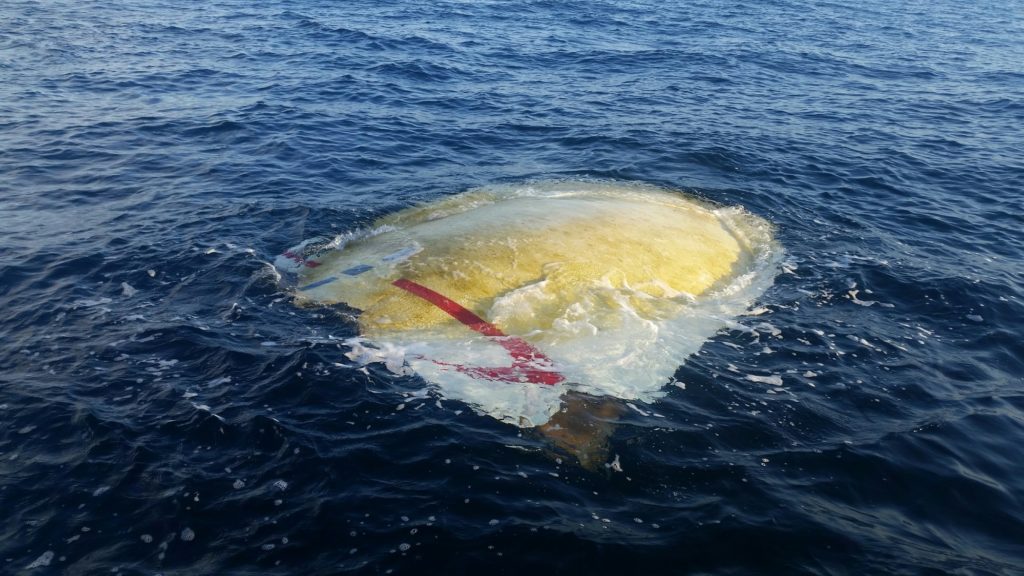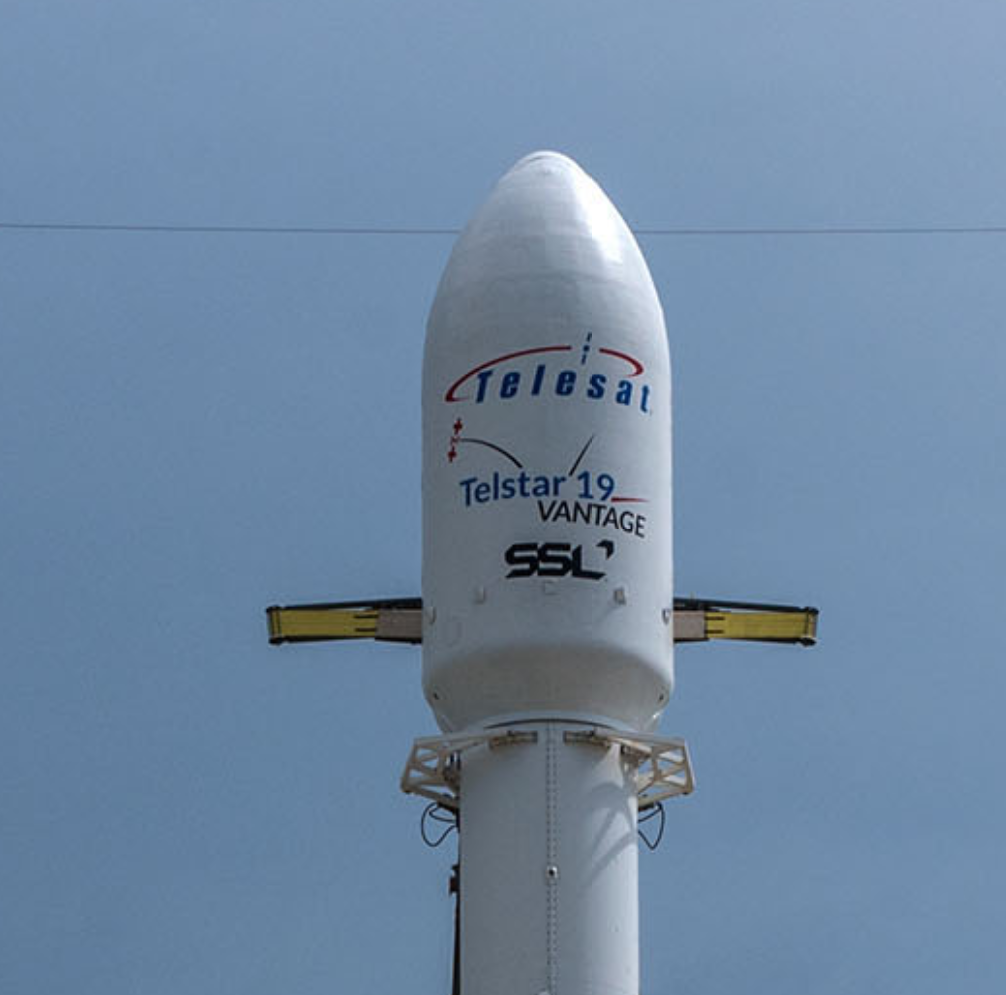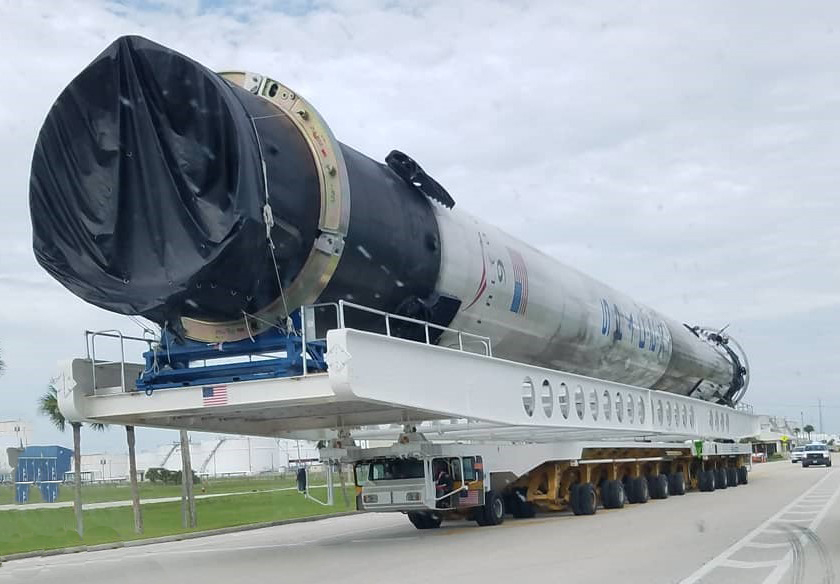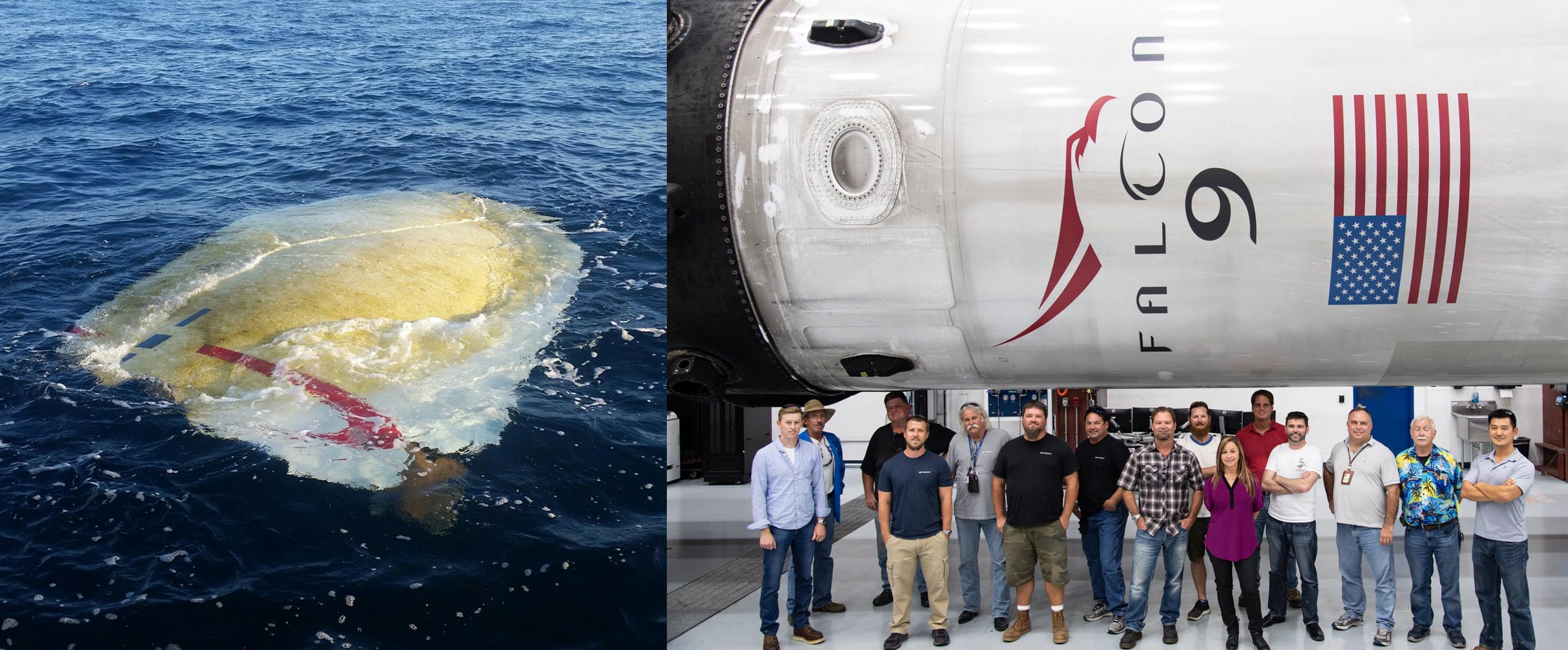
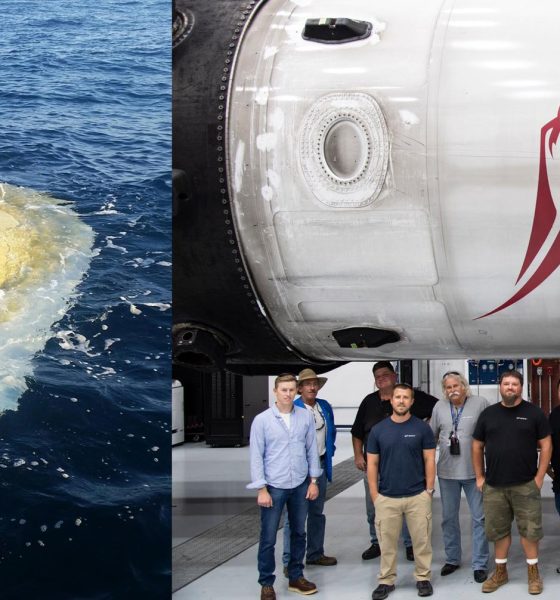
SpaceX
SpaceX Falcon 9 Block 5 booster preps for next launch as fairing fragments surface
As part of a recent 10-year anniversary celebration of SpaceX’s first successful launch to reach orbit, Falcon 9 B1047 was spotted undergoing inspections and refurbishment after the Block 5 booster’s launch debut, placing the 7-ton Telstar 19V communications satellite in orbit on July 22nd.
Meanwhile, a bit north of B1047’s cozy Cape Canaveral refurbishment hangar, battered fragments of a Falcon 9 payload fairing half – part of the very same Telstar 19V mission – were discovered by a fisherman off the coast of South Carolina.
https://twitter.com/SpaceXJobs/status/1045832573471969281?ref_src=twsrc%5Etfw%7Ctwcamp%5Etweetembed%7Ctwterm%5E1045832573471969281&ref_url=https%3A%2F%2Fwww.teslarati.com%2Fwp-admin%2Fpost.php%3Fpost%3D84909%26action%3Dedit
A tale of two halves
Around nine minutes after lifting off from SpaceX’s LC-40 pad, Falcon 9 B1047 gracefully landed on drone ship Of Course I Still Love You (OCISLY), followed soon after by confirmation of Falcon 9 Block 5’s second launch success. Perhaps a tad toasty after what one might call a ‘medium-well’ reentry, the upgraded booster was otherwise perfectly intact. A minute after B1047 separated from Falcon 9’s upper stage and Telstar 19V payload, the fairing – tasked with protecting the satellite from the stresses of high-speed atmospheric flight – was jettisoned from the second stage, splitting into two halves and falling away from the rocket in order to save precious mass on S2’s push towards orbit.
Falcon 9’s first stage separates from the upper stage for quite different reasons, cued quite literally by its propellant tanks essentially reaching “empty” – albeit an “empty” that typically includes some fumes for the booster’s safe recovery. The payload fairing, on the other hand, is detached from the second stage the moment that Falcon rises above a particular point in Earth’s atmosphere, only exposing its sensitive satellite(s) to the elements once in near-vacuum conditions. Ultimately, fairing halves separate from Falcon 9 at velocities significantly higher than that of the booster but are subjected to far more forgiving reentry conditions, requiring just a minimal of thermal protection to make it to (or just above…) the ground/ocean unscathed.
Detailed images of GO Pursuit returning to Port Canaveral this afternoon with a partial fairing half following Sunday’s launch of Falcon 9 and Telstar 19V. Damage is no surprise, as these east coast fairings — for now — land in the water. pic.twitter.com/AxkwUQH67b
— John Kraus (@johnkrausphotos) July 24, 2018
SpaceX recently began seriously attempting to recover Falcon 9 payload fairings, albeit almost exclusively during West Coast launches in order to let Mr. Steven attempt to catch the parasailing halves in the Pacific Ocean. Thus far, SpaceX engineers and technicians have not yet solved the challenging problems, although fairing halves have reportedly landed as few as 50 meters from Mr. Steven’s grasp and at least five have been recovered intact after landing gently on the ocean surface. On the East Coast, Falcon fairings are not nearly as lucky, typically alternating between smashing directly into the ocean and landing gently upon it, depending SpaceX’s need for experimental recovery data.
By all appearances, B1047’s fairing halves both plummeted – unarrested – into the Atlantic, shattering into pieces of fragile carbon fiber-aluminum honeycomb. Thanks to the extremely lightweight nature of their composition, even waterlogged fairing fragments tend to float almost indefinitely, winding up in far-flung places many hundreds or thousands of miles from the point of impact. A particularly large fairing fragment from Telstar 19V clearly survived its greater halve’s violent ends, floating its way 600-800 miles northwest to the coast of South Carolina. After taking photos, the fisherman rather poetically let it float away, permitting it several more weeks of freedom before washing up on some shoreline and making its way onto eBay.
- A Falcon 9 fairing fragment was discovered floating off the coast of South Carolina two months after launching with Telstar 19V. (TheHullTruth /u/gofish)
- Telstar 19V’s Falcon fairing artwork, a dead-ringer for the fairing flotsam. (SpaceX)
- B1047 returned safe and sound to Pad 39A for refurbishment less than a week after launching and landing. (Instagram /u/d_lo_ags)
Ultimately, SpaceX engineers and technicians will continue to work towards successful, reliable, and routine fairing recoveries, inevitably experiencing many failures before a functional solution is found and optimized, just like the teams that brought Falcon 9 first stage recovery from blueprint to reality. In the meantime, serendipitous events like this will continue to serve as both stark reminders of the unforgiving hurdles along the path to orbital-class rocket hardware recovery and the undeniable fact that it already can and has been done before.

News
SpaceX shades airline for seeking contract with Amazon’s Starlink rival

SpaceX employees, including its CEO Elon Musk, shaded American Airlines on social media this past weekend due to the company’s reported talks with Amazon’s Starlink rival, Leo.
Starlink has been adopted by several airlines, including United Airlines, Qatar Airways, Hawaiian Airlines, WestJet, Air France, airBaltic, and others. It has gained notoriety as an extremely solid, dependable, and reliable option for airline travel, as traditional options frequently cause users to lose connection to the internet.
Many airlines have made the switch, while others continue to mull the options available to them. American Airlines is one of them.
A report from Bloomberg indicates the airline is thinking of going with a Starlink rival owned by Amazon, called Leo. It was previously referred to as Project Kuiper.
American CEO Robert Isom said (via Bloomberg):
“While there’s Starlink, there are other low-Earth-orbit satellite opportunities that we can look at. We’re making sure that American is going to have what our customers need.”
Isom also said American has been in touch with Amazon about installing Leo on its aircraft, but he would not reveal the status of any discussions with the company.
The report caught the attention of Michael Nicolls, the Vice President of Starlink Engineering at SpaceX, who said:
“Only fly on airlines with good connectivity… and only one source of good connectivity at the moment…”
CEO Elon Musk replied to Nicolls by stating that American Airlines risks losing “a lot of customers if their connectivity solution fails.”
American Airlines will lose a lot of customers if their connectivity solution fails
— Elon Musk (@elonmusk) December 14, 2025
There are over 8,000 Starlink satellites in orbit currently, offering internet coverage in over 150 countries and territories globally. SpaceX expands its array of satellites nearly every week with launches from California and Florida, aiming to offer internet access to everyone across the globe.
Currently, the company is focusing on expanding into new markets, such as Africa and Asia.
News
Tesla hints at Starlink integration with recent patent
“By employing polymer blends, some examples enable RF transmission from all the modules to satellites and other communication devices both inside and outside the vehicle.”

Tesla hinted at a potential Starlink internet terminal integration within its vehicles in a recent patent, which describes a vehicle roof assembly with integrated radio frequency (RF) transparency.
The patent, which is Pub. No U.S. 2025/0368267 describes a new vehicle roof that is made of RF-transparent polymer materials, allowing and “facilitating clear communication with external devices and satellites.”
Tesla believes that a new vehicle roof design, comprised of different materials than the standard metallic or glass elements used in cars today, would allow the company to integrate modern vehicular technologies, “particularly those requiring radio frequency transmission and reception.
Tesla has recently filed a US patent application on integrating RF transparent materials into the roof structure.
“facilitating clear communication with external devices and satellites”
Tesla fleet is getting @Starlink connectivity integration soon. LFG @Tesla @elonmusk… pic.twitter.com/bLa8YtPLd1
— Chansoo Byeon (@Chansoo) December 9, 2025
Instead of glass or metallic materials, Tesla says vehicles may benefit from high-strength polymer blends, such as Polycarbonate, Acrylonitrile Butadiene Styrene, or Acrylonitrile Styrene Acrylate.
These materials still provide ideal strength metrics for crashworthiness, stiffness for noise, vibration, and harshness control, and are compliant with head impact regulations.
They would also enable better performance with modern technologies, like internet terminals, which need an uninterrupted signal to satellites for maximum reception. Tesla writes in the patent:
“By employing polymer blends, some examples enable RF transmission from all the modules to satellites and other communication devices both inside and outside the vehicle.”

One of the challenges Tesla seems to be aware of with this type of roof design is the fact that it will still have to enable safety and keep that at the forefront of the design. As you can see in the illustration above, Tesla plans to use four layers to increase safety and rigidity, while also combating noise and vibration.
It notes in the patent that disclosed examples still meet the safety requirements outlined in the Federal Motor Vehicle Safety Standards (FMVSS).
Starlink integrated directly into Tesla vehicles would be a considerable advantage for owners. It would come with a handful of distinct advantages.
Initially, the inclusion of Starlink would completely eliminate cellular dead zones, something that is an issue, especially in rural areas. Starlink would provide connectivity in these remote regions and would ensure uninterrupted service during road trips and off-grid adventures.
It could also be a critical addition for Robotaxi, as it is crucial to have solid and reliable connectivity for remote monitoring and fleet management.
Starlink’s growing constellation, thanks to SpaceX’s routine and frequent launch schedule, will provide secure, stable, and reliable internet connectivity for Tesla vehicles.
Although many owners have already mounted Starlink Mini dishes under their glass roofs for a similar experience, it may be integrated directly into Teslas in the coming years, either as an upgrade or a standard feature.
Investor's Corner
SpaceX IPO is coming, CEO Elon Musk confirms
However, it appears Musk is ready for SpaceX to go public, as Ars Technica Senior Space Editor Eric Berger wrote an op-ed that indicated he thought SpaceX would go public soon. Musk replied, basically confirming it.

Elon Musk confirmed through a post on X that a SpaceX initial public offering (IPO) is on the way after hinting at it several times earlier this year.
It also comes one day after Bloomberg reported that SpaceX was aiming for a valuation of $1.5 trillion, adding that it wanted to raise $30 billion.
Musk has been transparent for most of the year that he wanted to try to figure out a way to get Tesla shareholders to invest in SpaceX, giving them access to the stock.
He has also recognized the issues of having a public stock, like litigation exposure, quarterly reporting pressures, and other inconveniences.
However, it appears Musk is ready for SpaceX to go public, as Ars Technica Senior Space Editor Eric Berger wrote an op-ed that indicated he thought SpaceX would go public soon.
Musk replied, basically confirming it:
As usual, Eric is accurate
— Elon Musk (@elonmusk) December 10, 2025
Berger believes the IPO would help support the need for $30 billion or more in capital needed to fund AI integration projects, such as space-based data centers and lunar satellite factories. Musk confirmed recently that SpaceX “will be doing” data centers in orbit.
AI appears to be a “key part” of SpaceX getting to Musk, Berger also wrote. When writing about whether or not Optimus is a viable project and product for the company, he says that none of that matters. Musk thinks it is, and that’s all that matters.
It seems like Musk has certainly mulled something this big for a very long time, and the idea of taking SpaceX public is not just likely; it is necessary for the company to get to Mars.
The details of when SpaceX will finally hit that public status are not known. Many of the reports that came out over the past few days indicate it would happen in 2026, so sooner rather than later.
But there are a lot of things on Musk’s plate early next year, especially with Cybercab production, the potential launch of Unsupervised Full Self-Driving, and the Roadster unveiling, all planned for Q1.
